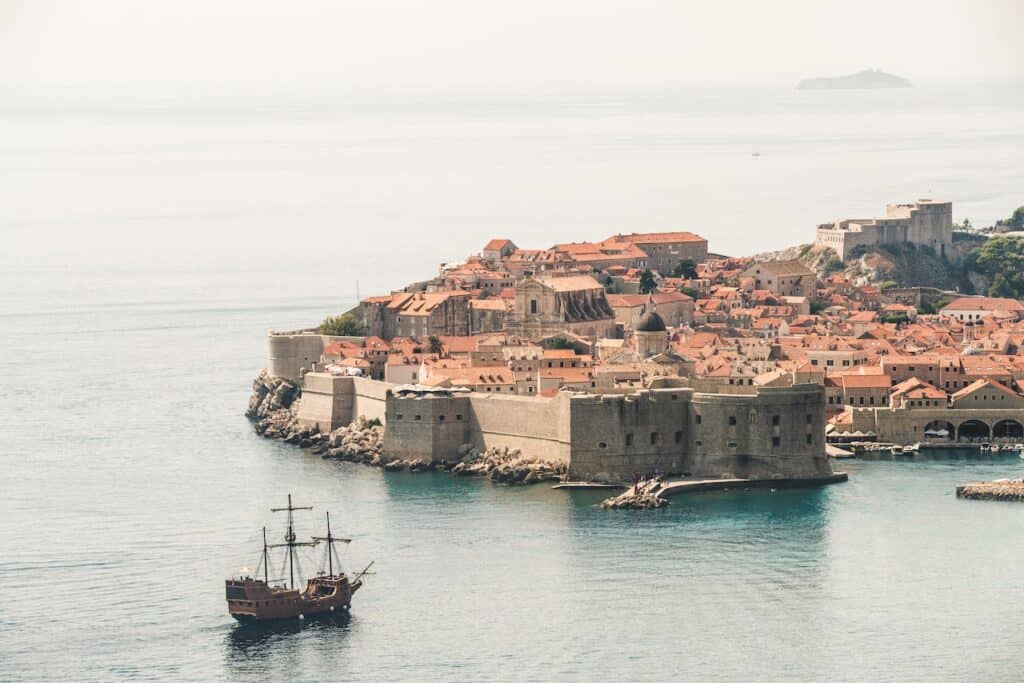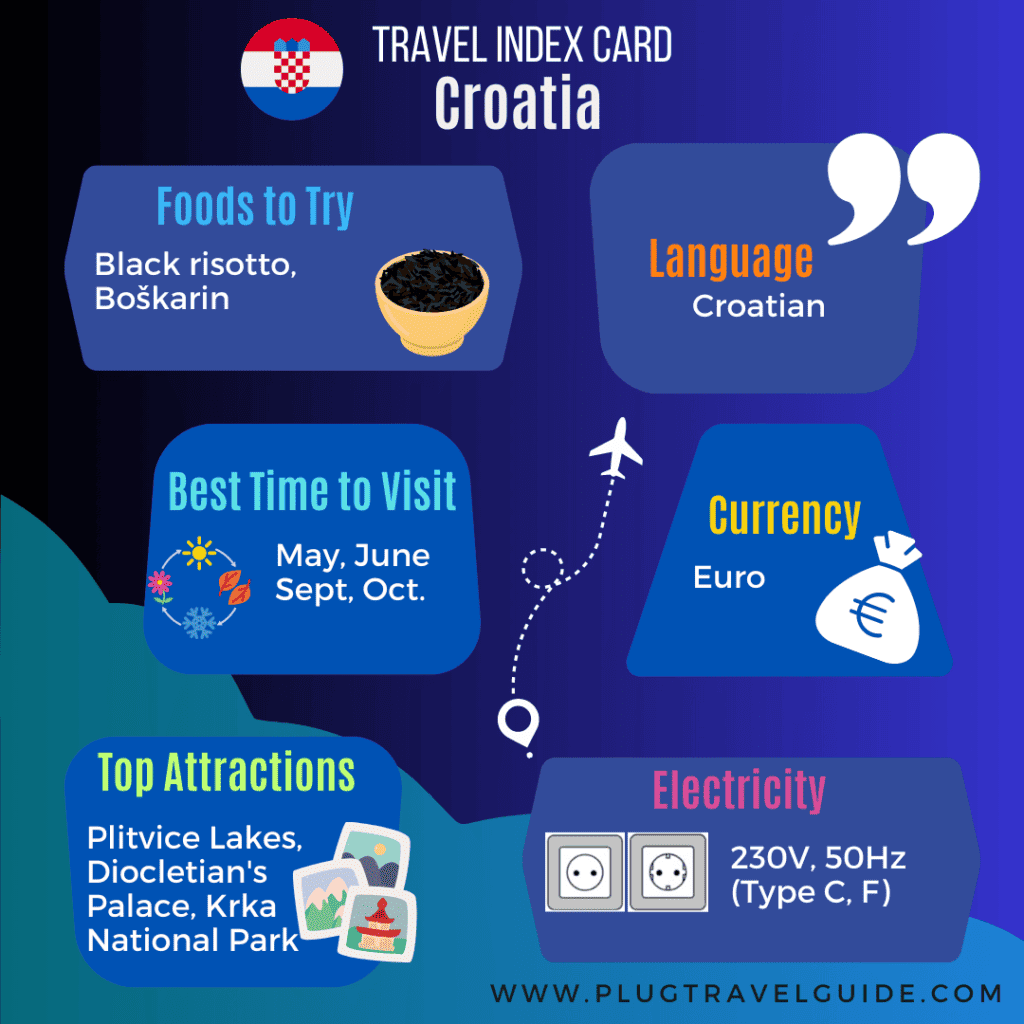Plug For Croatia: What You Need To Know

What is the plug for Croatia? Before you travel, check the information below to make sure your electronic devices are compatible with the outlet type and voltage.
Electrical Summary
Croatia uses outlet type C and F at a voltage of 230V and a frequency of 50 Hz.
Plug Compatibility: Type C, Type F
Voltage: 230V
Frequency: 50 Hz
Type C

Type F

Can North Americans use Electronics in Croatia without an Adapter?
No! North Americans will need an adapter for the outlets and a transformer for the voltage when traveling to Croatia. North Americans device plugs will not work with the outlet types in Croatia. Also, the voltage in Croatia is different from North American voltages.
Can Europeans use Electronics in Croatia without an adapter?
Yes! Europeans do not need a travel adapter or transformer when traveling to Croatia. Most device plugs will work with the outlet types in Croatia. Also, the voltage in Croatia is the same as in Europe.
What Outlet does Croatia Use?
Type C

Type C plug sockets are used in Europe, Africa and Asia. They have two round pins and no grounding pin. These plugs are typically used with devices that have a voltage of 220-240V. This outlet is rated for 2.5 amps. Plug Type E, and Type F are compatible with this socket. All other plug types will need an adapter.
Type F

Type F electrical plug sockets are used in Germany, Spain, Italy and some parts of Africa. They have two round pins and a grounding pin. These outlets are typically used with devices that have a voltage of 220-240V. This outlet is rated for 16 amps. Plug Type C and Type E are compatible with this socket. All other plug types will need an adapter.

Is it safe to drink water in Croatia?
The safety of drinking water in Croatia is generally good. According to the World Health Organization (WHO), more than 99% of the population in Croatia has access to improved drinking water sources, which means that the water is from a protected well or spring, or treated through a piped system.
The water treatment system in Croatia is modern and meets European Union standards, and the tap water is safe to drink in most urban areas. However, in rural areas, the water quality may not be as good due to poor sanitation and lack of treatment facilities.
Even if the tap water is considered safe to drink in Croatia, it is still advisable to take precautions to avoid potential contamination. For example, it is recommended to boil tap water before drinking it or to use a water filter.
Alternatively, bottled water is widely available and is a safe option for drinking in Croatia. It is essential to ensure that the seal is intact before consuming the bottled water.
If you are traveling to Croatia, it is recommended to consult with a healthcare provider or a travel health specialist for specific recommendations on how to stay healthy and avoid waterborne diseases.
We recommend always packing a filtered water bottle when traveling:
Travel Essentials
Be sure to check our list of travel essentials before your trip!
Should I get travel insurance when traveling to Croatia?
It is generally recommended to get travel insurance when traveling to a different country. Travel insurance can provide financial protection and peace of mind in case of unexpected events, such as medical emergencies, trip cancellations, lost or stolen baggage, or other travel-related mishaps.
Travel insurance can cover various expenses related to your trip, such as medical expenses, emergency medical transportation, trip cancellation or interruption, lost or stolen baggage or personal belongings, and other travel-related expenses.
Before purchasing travel insurance, it’s important to carefully review the policy details, including the coverage limits, exclusions, and any applicable deductibles or co-pays. You should also make sure that the policy covers any activities or destinations that you plan to participate in or visit during your trip.
Travel Summary
Where is Croatia?
Croatia is a country located in Southeast Europe, bordered by Slovenia to the northwest, Hungary to the northeast, Serbia to the east, Bosnia and Herzegovina to the southeast, Montenegro to the southeast, and the Adriatic Sea to the southwest.
What time is it in Croatia?
Croatia is in the Central European Time (CET) zone, which is 1 hour ahead of Coordinated Universal Time (UTC+1).
What language do they speak in Croatia?
The official language of Croatia is Croatian, which is a member of the Slavic language family.
Where is Croatia on the map?
Croatia is located in southeastern Europe, along the Adriatic Sea.
What is the capital of Croatia?
The capital of Croatia is Zagreb.
What to do in Croatia?
Croatia is known for its beautiful coastline and historic cities. Some popular things to do in Croatia include visiting the cities of Dubrovnik, Split, and Zagreb, exploring the Plitvice Lakes National Park, and enjoying the beaches and crystal-clear waters of the Adriatic Sea.
Where to go in Croatia?
Croatia has a lot to offer, from its stunning coastline and beaches to its historic cities and national parks. Some popular destinations in Croatia include Dubrovnik, Split, Hvar, Zadar, and the Plitvice Lakes National Park. Depending on your interests, you could also visit the Istrian Peninsula, the island of Korčula, or the capital city of Zagreb.
Dubrovnik, known as the “Pearl of the Adriatic,” is a must-see destination for visitors to Croatia. The walled city, a UNESCO World Heritage site, is home to stunning medieval architecture, including the iconic Old Town walls and the Rector’s Palace. Visitors can also take a cable car to the top of Mount Srd for panoramic views of the city and the sea.
Split, the second-largest city in Croatia, is another popular destination, with a mix of Roman ruins and modern attractions. The Diocletian’s Palace, a UNESCO World Heritage site, is a well-preserved ancient palace that now serves as a bustling city center, with cafés, restaurants, and shops. Visitors can also take a ferry from Split to the nearby islands of Brac, Hvar, and Vis, known for their beaches, nightlife, and scenic landscapes.
Croatia is also home to eight national parks, including the Plitvice Lakes National Park, a UNESCO World Heritage site known for its cascading lakes and waterfalls. Visitors can also explore the Krka National Park, with its dramatic waterfalls and scenic hiking trails.
The country’s cuisine is a mix of Mediterranean and Central European influences, with seafood, pasta, and grilled meats featuring prominently on menus. Local wines, olive oil, and truffles are also highlights of the Croatian food scene.
Croatia is a welcoming destination for travelers, with a strong focus on tourism. The official language is Croatian, but many people speak English as well. With its mix of historic cities, stunning coastline, and natural beauty, Croatia is a must-visit destination for anyone looking to explore Central Europe.
Traveling to another country? Check out our Countries page for more info.